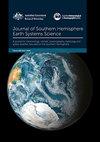澳大利亚四个城市的大季节性和昼夜人为热通量
IF 3.6
4区 地球科学
Q1 Earth and Planetary Sciences
引用次数: 0
摘要
人为热释放是城市热岛的重要组成部分。然而,由于没有可靠的估计,它经常被排除在城市热岛的研究之外。这一遗漏很重要,因为人为热可使城市热岛升温高达4ºC,并增加城市居民的热应力。排除人为热意味着城市热岛效应对温度的影响可能被低估。在这里,我们估计了澳大利亚四个首都城市(布里斯班、悉尼、墨尔本和阿德莱德)的人为热量,为气候变化下的城市热岛管理提供信息。人为热量释放是根据2011年人口普查数据和每小时交通量、建筑用电和燃气使用的清单计算出来的。墨尔本的年平均人为热排放量最高,白天在市中心达到376 W/m2,而布里斯班的排放量为261 W/m2,悉尼为256W/m2。阿德莱德的排放量最低,市中心的日平均排放量为39瓦/平方米。四个城市内部和城市之间的排放量各不相同,随着距离市中心的距离而迅速下降,布里斯班在距离市中心20公里时为2,阿德莱德在距离市中心15公里时为2。在工作时间,城市中心的排放量最高。墨尔本市中心达到的峰值排放量与伦敦和东京的峰值排放量相似,在伦敦和东京,人为热量是城市热岛的很大一部分。这表明人为热量可能是澳大利亚首都城市热岛的一个重要因素,需要在气候适应研究中加以考虑。这是一个重要的问题,因为气候变化,加上人口老龄化和城市增长,在未来40年里,澳大利亚城市热浪造成的死亡人数可能会增加一倍。本文章由计算机程序翻译,如有差异,请以英文原文为准。
Large seasonal and diurnal anthropogenic heat flux across four Australian cities
Anthropogenic heat release is a key component of the urban heat island. However, it is often excluded from studies of the urban heat island because reliable estimates are not available. This omission is important because anthropogenic heat can contribute up to 4ºC to the urban heat island, and increases heat stress to urban residents. The exclusion of anthropogenic heat means the urban heat island effect on temperatures may be under-estimated. Here we estimate anthropogenic heat for four Australian capital cities (Brisbane, Sydney, Melbourne and Adelaide) to inform the management of the urban heat island in a changing climate. Anthropogenic heat release was calculated using 2011 population census data and an inventory of hourly traffic volume, building electricity and gas use. Melbourne had the highest annual daily average anthropogenic heat emissions, which reached 376 W/m2in the city centre during the daytime, while Brisbane’s emissions were 261 W/m2 and Sydney’s were 256W/m2. Adelaide had the lowest emissions, with a daily average of 39 W/m2 in the city centre. Emissions varied within and among the four cities and decreased rapidly with distance from the city centre, to 2 at 20 km from the city in Brisbane, and 15 km in Adelaide. The highest emissions were found in the city centres during working hours. The peak emissions reached in the centre of Melbourne are similar to the peak emissions in London and Tokyo, where anthropogenic heat is a large component of the urban heat island. This indicates that anthropogenic heat could be an important contributor to the urban heat island in Australian capital cities, and needs to be considered in climate adaptation studies. This is an important problem because climate change, combined with an ageing population and urban growth, could double the deaths from heatwaves in Australian cities over the next 40 years.
求助全文
通过发布文献求助,成功后即可免费获取论文全文。
去求助
来源期刊

Journal of Southern Hemisphere Earth Systems Science
Earth and Planetary Sciences-Oceanography
CiteScore
8.10
自引率
8.30%
发文量
0
审稿时长
>12 weeks
期刊介绍:
The Journal of Southern Hemisphere Earth Systems Science (JSHESS) publishes broad areas of research with a distinct emphasis on the Southern Hemisphere. The scope of the Journal encompasses the study of the mean state, variability and change of the atmosphere, oceans, and land surface, including the cryosphere, from hemispheric to regional scales.
general circulation of the atmosphere and oceans,
climate change and variability ,
climate impacts,
climate modelling ,
past change in the climate system including palaeoclimate variability,
atmospheric dynamics,
synoptic meteorology,
mesoscale meteorology and severe weather,
tropical meteorology,
observation systems,
remote sensing of atmospheric, oceanic and land surface processes,
weather, climate and ocean prediction,
atmospheric and oceanic composition and chemistry,
physical oceanography,
air‐sea interactions,
coastal zone processes,
hydrology,
cryosphere‐atmosphere interactions,
land surface‐atmosphere interactions,
space weather, including impacts and mitigation on technology,
ionospheric, magnetospheric, auroral and space physics,
data assimilation applied to the above subject areas .
Authors are encouraged to contact the Editor for specific advice on whether the subject matter of a proposed submission is appropriate for the Journal of Southern Hemisphere Earth Systems Science.
 求助内容:
求助内容: 应助结果提醒方式:
应助结果提醒方式:


